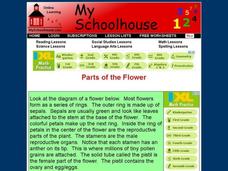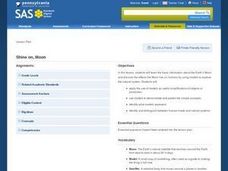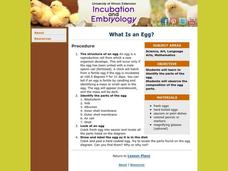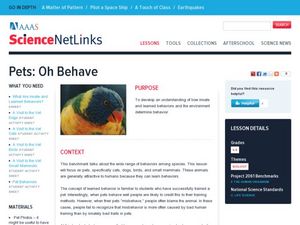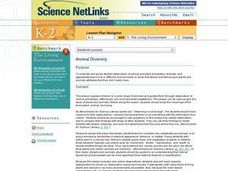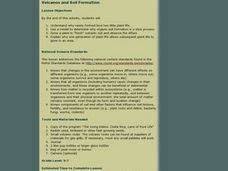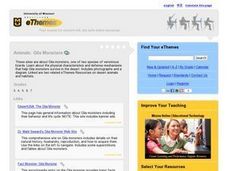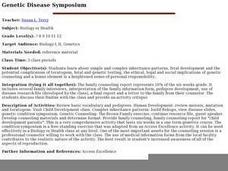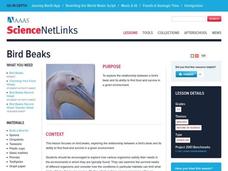Curated OER
Ocean Life Zones Notes
For this ocean zones worksheet, learners label the ocean diagram with the different zones. Then students write in animals that live in each of the zones and research basic information about those animals. This worksheet has 6 fill in the...
Curated OER
Parts of the Flower
In this biology worksheet, students examine a diagram of a flower and read a selection that describes all of the parts including the petals, the stamen, the anther, and the sepals. They answer 11 on-line fill in the blank questions using...
Curated OER
Steps for Taking a Cutting for Your Own Forest at Home
Students study renewable and nonrenewable resources and take a hardwood cutting. In this hands on activity students learn what rooting hormones are, how they generate roots and then take their own cutting and root it.
Curated OER
Microbe Multiplication Magic
Students discover how microbes multiply. In this infectious disease lesson, students calculate the growth of bacteria in various environments. Students determine the role that the environment plays in the spread of infectious disease.
Curated OER
Protist Crossword
In this protist learning exercise, students complete a crossword puzzle with 34 questions about the behaviour and different types of protists.
Curated OER
Sponges and Cnidarian Crossword Puzzle
In this marine science worksheet, students complete a crossword puzzle with 32 questions on sponges and cnidarian. They identify the different characteristics of sponges and cnidarian.
Curated OER
Populations – The Survival of the Fittest (Part 1)
Students explain in their own words why organisms live together. In this biology instructional activity, students model what happens to organisms if their environment changes. They explain the importance of evolution.
Pennsylvania Department of Education
Pennsylvania’s Energy Supply
Third graders become familiar with the various types of energy and which types are found in Pennsylvania. In this Pennsylvanian energy resources lesson, 3rd graders, identify wind and water as sources of energy. Students complete an...
Pennsylvania Department of Education
Wind and Water Wheels
Students identify wind and water as natural resources that create energy. In this natural resources and energy use lesson, students work in groups to construct a pinwheel, then explore the effects of wind and water on the pinwheel....
Curated OER
Shine On, Moon
Pupils explore space science by conducting an experiment in class. In this Moon lesson, students define a list of space science vocabulary and read the book The Moon. Pupils utilize shoeboxes and string to conduct a sunlight experiment...
Curated OER
What Is an Egg?
Students identify the parts of the egg and observe the composition of the egg parts.
Curated OER
Biotechnology in Agriculture: Non-surgical removal of fertilized embryos from the Bovine Uterus
Students simulate the step-by-step procedures needed to non-surgically remove embryos from the uterus of a superovulated cow using the Kalver training cow.
Curated OER
Rx Rainforest:
Students identify plant diversity in the rainforest and the role that animals and habitats play in scientific research. They differentiate between natural habitat and laboratory research and work collaboratively to produce a video news...
Curated OER
Who's Coming to Dinner?
Young scholars identify the role predators/prey play in food chains, differentiate between food chains and webs, identify factors that affect the balance in food webs, and propose solutions to protect endangered species' environments and...
Curated OER
Making Blood!
students research blood's components, and use their math skills to recreate a model of whole blood using commonly found food items.
Curated OER
Pets: Oh Behave
Students develop an understanding of how innate and learned behaviors and the environment determine behavior.
Curated OER
Animal Diversity
Students use the Animal Diversity E-Sheet to access the Where Can Animals Live? online book.
Curated OER
The Rain Forest
Students research the rainforest and re-create it using music, lighting, and sounds.
Curated OER
Why So Many Frogs?
Young scholars explain the different stages in the growth of a frog, then analyze and collect data to make generalizations about a larger population. They determine the survival rate of a population of tadpoles under controlled conditions.
Curated OER
Animals: Gila Monsters
Students research sites about Gila monsters. They explore the physical characteristics and defense mechanisms that help Gila monsters survive in the desert. Includes photographs and a diagram.
Curated OER
Hardy-Weinberg Equilibrium According to Hoyle:
Students gain a feeling for the significance of the Hardy-Weinberg Equilibrium without using algebra but participating in an interactice game.
Curated OER
Genetic Disease Symposium
Students research simple and complex inheritance patterns, fetal development and the potential complications of teratogens, fetal and genetic testing, and the ethical, legal, and social implications of genetic counseling.
Curated OER
Bird Beaks
Students explore the relationship between a bird's beak and its ability to find food and survive in a given environment.
Curated OER
Signs of Autumn
Second graders study photosynthesis and explore how chlorophyll is important to leaves and why leaves change colors in the fall.
Other popular searches
- Cell Reproduction
- Asexual Reproduction
- Sexual Reproduction
- Plant Reproduction
- Human Reproduction
- Flower Reproduction
- Animal Reproduction
- Heredity and Reproduction
- Sexual Asexual Reproduction
- Cell Reproduction Crossword
- Human Sexual Reproduction
- Cellular Reproduction



